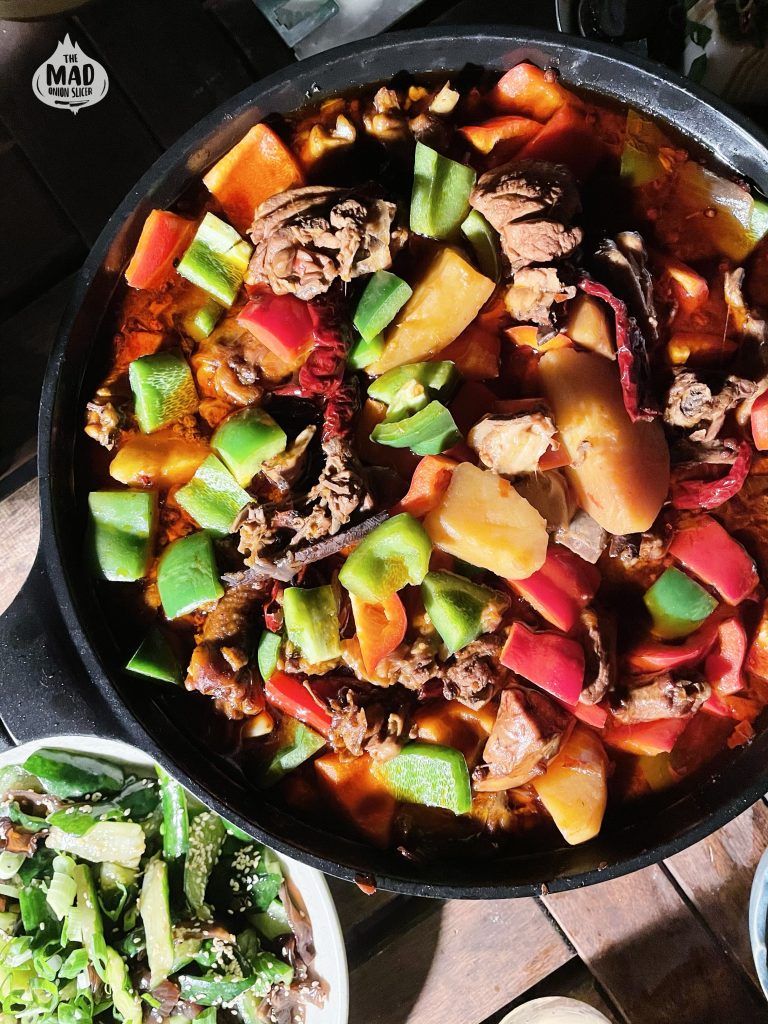Man, I love this thing. Dapanji simply translates to Big Plate of Chicken and is easily one of the most delicious Chinese dishes I’ve picked up over the years. The Uyghurs from the Xinjiang province of China have a fantastic cuisine, that mixes Chinese and Central Asian flavours and packs a real punch. When I first cooked Dapanji, I was surprised to see some very familiar spices in the recipe. Combining these spices with Chinese techniques and ingredients resulted in something truly unique and flavourful.

If you’re in India, and looking to buy the ingredients, here’s the link to my Amazon list: https://bit.ly/dapanji
Here’s the recipe:
- Make a simple dough using the following 250 gm bread flour, 1/2 tsp salt and 125 ml water
- Mix together the flour and salt, then slowly incorporate the water into the dough. Knead till smooth.
- Divide the dough into 8 pieces
- Shape the pieces into logs and coat them with 1 tsp of vegetable oil each. Make sure they’re nice and shiny, so that they don’t dry out.
- Cover the logs with clingfilm or a lid and let them rest for an hour at least. Super important step. You need to let the dough rest for gluten to form.
THE CHICKEN
- Chop and soak 15 dry red chillies in a cup of water. Use a mild chilli like Kashmiri, that will bring more colour and less heat.
- Let’s make Tangse (caramel)! In a wok, heat 5 tbsp vegetable oil and add 4 tbsp sugar and mix carefully. Keep stirring till the sugar dissolves and starts turning brown. Don’t let it get too dark. We’re going for brown, not black.
- Once the sugar turns brown, add 1 chopped chicken to the wok. The chicken needs to have the skin on, and be chopped into medium sized pieces. The skin adds a ton of flavour, and keeping the pieces small – medium will ensure they cook fast. How small should they be? Each piece should roughly be the size of an Apple Airpods case.
- Add 2 tbsp Shaoxing cooking wine and fry the chicken on high heat for 3 min, stirring all the time.
- Throw in 3 tbsp each of sliced ginger and garlic. Crumble 1 cube of Chicken bouillion or chicken stock and mix well.
- Add the chopped and soaked red chilli + 2 tbsp of the best damn Doubanjiang you can get. Doubanjiang / Toban Djan is spicy fermented chilli and broad bean paste and really brings a lot of flavour to the dish.
- Time for some spices. Throw in 1 big bay leaf, 3 black cardamoms, 3 sticks of cinnamon, 3 star anise, and 2 tbsp Sichuan peppercorns. Mix well and fry for 2 minutes.
- Now add 3 peeled and quartered potatoes, and 3 hot red chillies. You can add as much Chilli as you like, but be careful not to overdo it because the Doubanjiang also has chilli in it.
- Add 400 ml water, 1 tbsp light soy sauce and bring your braising liquid to a simmer.
- Cover with a lid and cook for 25 min. The potatoes should have cooked in this much time. If they’re still tough, cook a little longer. They should be cooked, but not start breaking or the whole thing will thicken up. Cool? Cool.
- Open, throw in 1 cup chopped leeks or spring onion whites, one onion, one green pepper and one red pepper cut into large cubes. Now a lot of people like to throw some fresh garlic in at this stage. If you like a little bite to your garlic go ahead and add 4 sliced cloves of garlic.
- Cover and cook for another 10 min. Don’t overcook. The peppers should still have a bite to them. Now leave the thing alone and get started on your noodles.
THE NOODLES
This part of the recipe is more about skill really. You will probably suck at noodle pulling the first few times, but don’t worry. They will still taste great.
- Go and grab one of those logs of dough that we rested earlier. On a counter top, flatten the log with your hand by pressing it firmly. You’re trying to make a ribbon at this stage.
- Once flattened, hold each end of the noodle and stretch it 4 times. Make sure it doesn’t break.
- Now, the pulling and smacking starts. Pull the noodle and smack it on the counter. With every smack, the noodle will become more elongated and elastic.
- If your noodle breaks however, there’s no rolling it back into a ball and starting again. The oil wont allow that to happen. Simply flatten against the counter using your hands and make some kind of noodle. Try not to cry.
- Anyway, once you have a nice big flat noodle, it’s time to cook it
- Add it to a pot of boiling water. Simply boil till the noodle floats. Should take 2 min tops. If your noodle is super thick, then just cook a little longer.
THE ASSEMBLY
Place the noodles in a bowl. Generously spoon the Dapanji on top. The noodles will start absorbing all that beautiful braising liquid from the Dapanji and you, my friend will have a very very satisfying meal indeed.
Over and out!